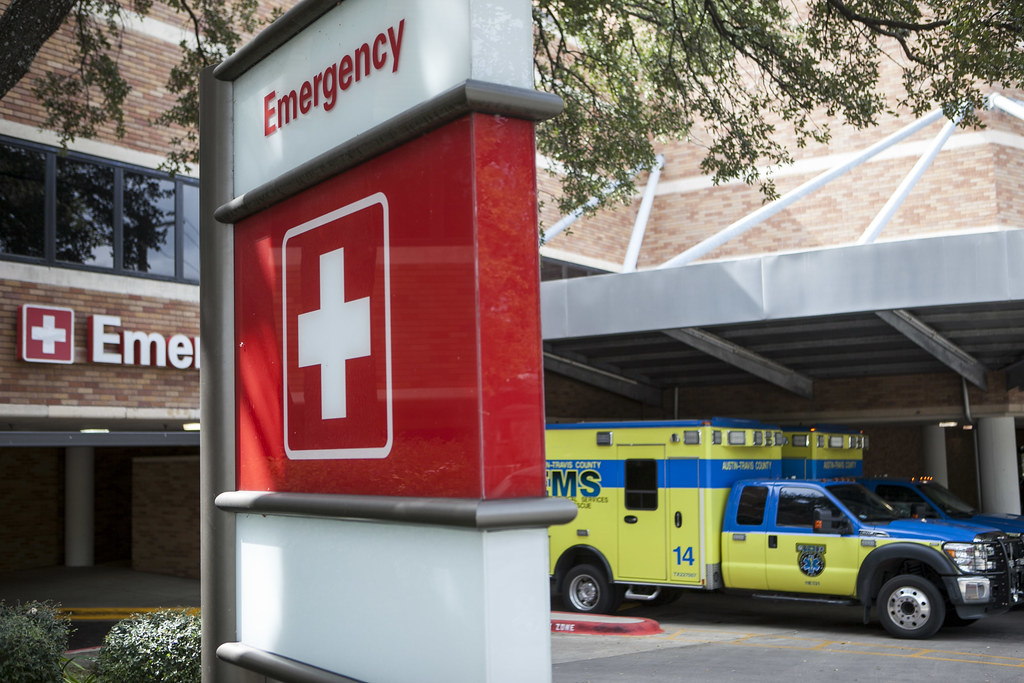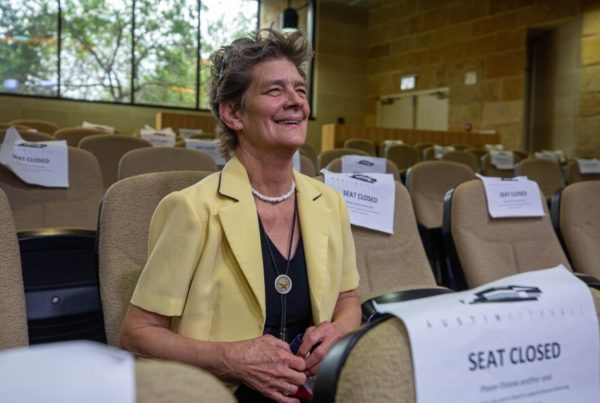Almost 60% of Texans are fully vaccinated against COVID-19, but the recent surge of the omicron variant has caused many so-called breakthrough cases in people who’ve had their shots.
The good news so far is that omicron seems to be causing less severe illness in vaccinated people. The bad news is that omicron spreads much more easily than other variants, and it’s infecting many more health care workers and putting a strain on colleagues who have to cover in their absence. Some have expressed the feeling of being at a breaking point because of the extra burden.
Emergency room Dr. Ewan Johnson has seen firsthand the effects of the omicron surge in hospitals across the state. Johnson is a board member of Harris Health System and of HCA Houston Healthcare, Tomball. Johnson spoke with Texas Standard about what it’s like to treat patients all over the state, how important it is to get vaccinated and to stay away from ivermectin. Listen to the interview in the audio player above or read the transcript below.
This interview has been edited lightly for clarity.
Texas Standard: You grew up in Houston and I understand you’re still practicing there. But during the pandemic, you’ve been working in ER rooms across Texas. Why?
Dr. Ewan Johnson: Most of my training has been done in the Texas Medical Center, Houston. And so you ask yourself during this time of crisis, whether or not you want to be on the front lines to help Texans during this time. And so I wanted to get out there and be on the front line, not running away. I’ve often said that for the health care professionals, this is our war. We’ve been trained for this and so it’s very important for us to stand up and reach out to help those in need.
And so I chose to to get out into the communities where there is need and actually provide the assistance, whether I’m in the emergency room, and sometimes in the inpatient setting, whether it’s in the ICU. So I’m living it and I’m seeing it up close and personal and it is tiring, but it’s important and good work that we’re doing.
You say you’re seeing it up close and personal. What are you seeing? Can you paint a picture for us?
You’re seeing the effects of COVID-19. I’ve often said to patients living in the Gulf Coast, COVID-19 is like a storm and this storm ravages the body just like a storm will ravage the Gulf Coast, whether it’s the power lines down, a sinkhole, homes are destroyed. You see the effects of COVID on the individual patient. They present with stroke-like symptoms, they present with with chest pain, with shortness of breath, with weakness, organ dysfunction, etc., etc. And you, in the emergency room, have to really adjust and basically look at what you have to decide how to proceed.
And so all the organ systems are affected. A lot of people think you’ll present just with shortness of breath. But a lot of people will present with chest tightness and will show signs of acute coronary syndrome, heart attacks or basically weakness in the arms, the leg, confusion. And you’ve got to make adjustments and provide the care they need.
Are Texans without COVID, say, someone suffering from a heart attack or an injury from a car accident getting turned away, especially in more rural emergency rooms with less patient capacity? What are you experiencing with non-COVID patients?
Number one, the non-COVID patient, a lot of the patients, are afraid to actually come to the hospital because they’re afraid that they will contract COVID. And as a result of that, we see an uptick in the number of events cardiovascular, non-related to COVID or stroke non-related to COVID.
But in the rural settings, these, as I’ve often said, the residents of rural Texas, they deserve the same standard of care that they would get if they were sitting in a big city like Dallas or Houston. And when they show up, I can assure you from what I’ve seen, the staff, the nurses, respiratory lab, they do their very best to provide that level of care.
The problem occurs, for example, when the situation is beyond the scope of a rural hospital and you seek to try and transfer them. Let’s say this individual is in cardiogenic failure or they’re septic or require nephrology or some other specialty. The individual is unvaccinated and having symptoms suggestive of a cardiac or heart attack, and we basically have to find a place or an ICU where we have a cardiologist or somebody like that to properly manage the individual. And the phrase I’ve heard throughout the course of wherever I am, “Dr. Johnson, we cannot accept the patient unless we are talking about a major trauma or stroke that require thrombectomy. So if you’re if you’re a patient who does not meet that criteria, I’m sorry, but we’re on diversion.”
And so if you’re a rural hospital, the physicians there and staff there will now become the ICU and have to man that, take care of that patient, for the duration of time until such time that they can be transported.
That sounds like it’s one of the biggest distinctions between what you’re seeing in the rural setting and urban hospitals.
In the urban hospitals, you have the specialties there. The urban hospitals themselves are full. So again, not accepting. But if you show up to the ER in Tyler and you’re in need, they cannot turn you away, across the state, across the nation. But when you’re in a rural setting where limited capacity, limited resources are even at a standalone ER – those are the freestanding ERs – you have no place to go if you cannot find a bed anywhere.
I mean, I’ve had the opportunity to survey the entire state. Calling from Amarillo, Lubbock, Plainview out of East Texas, south to Corpus Christi, Dallas all the way to New Mexico. Sometimes we try to transfer patients to Colorado, Oklahoma to try and find a bed because you need a certain specialty. And if it’s not available in your area, you’re trying your damndest save this patient’s life.
Having been on the ground from day one since this pandemic started, what’s your message that you want to put out there? If people are trying to understand what’s going on, what would you say?
I’m going to say this and it’s not political, but get vaccinated. Get vaccinated, wear your mask, and ivermectin does not cure COVID-19 – ivermectin by itself does not cure or treat COVID 19. We’ve seen an uptick in individuals who are using this. They’re pasting it on themselves. They’re putting in their juice or milk and then ending up in the ER with the consequences of that. So those are two things: get vaccinated, please get vaccinated because if you’re not vaccinated, we know that disproportionately now, these individuals that are in the ICU or in the hospital are those who are unvaccinated and they are much more severe in terms of the symptomology that we see.
Is there a light at the end of the tunnel here? We’re hearing from some other states that cases seem to have plateaued. What are you seeing?
We’re, again, in Texas. We’re still seeing patients who are coming in who are still positive, who have been at home, battling it, with whatever remedy they have. And then when it’s unbearable, they show up. I just saw three or four people before before a call with you where I am right now. So it’s there, it’s real, it’s happening. And again, these folks are unvaccinated; they’re unvaccinated.
And as I’ve said, if I see 100 people lined up and they all have different co-morbidities, their [body mass index] is a variable across the board, multiple medical conditions, at this time, we cannot truly predict who will die, who will end up in the hospital and who will just pass through this without any major consequences. So we still are not there. The research is still required for us to be able to do that and make a determination of who is going to be the sickest. And I think we’ll get to that with research. We will get there with research.













